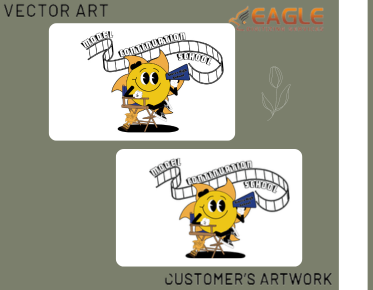Dive Deep: Understanding Alpha Channels and Their Impact on Vector Art
In the realm of graphicdesign, transparency is not merely a visual element; it’s a crucial tool that
can enhance the depth and richness of your artwork. Enter alpha channels, the
unsung heroes of the design world. These invisible layers of information
dictate how images interact with one another, allowing for seamless integration
of graphics in a myriad of contexts. This article delves into the significance
of alpha channels in vector art, unraveling their intricacies and demonstrating
how they can elevate your creative projects.
What Are Alpha Channels? A Brief Overview
Alpha channels
are essentially channels of data that manage the transparency levels of an
image. Think of them as a digital on-off switch that determines whether a pixel
is fully opaque, partially transparent, or completely transparent. While most
people are familiar with the concept of color channels—red, green, and
blue—alpha channels operate on a different plane, focusing solely on the
transparency aspect. This functionality is crucial in a world where layering
and compositing images are paramount to creating sophisticated designs.
Why Alpha Channels Matter in Vector Art Creation
In vector art,
where shapes and lines are defined mathematically rather than by pixels, alpha
channels allow artists to craft intricate visuals that blend seamlessly into
various backgrounds. The ability to manipulate transparency empowers designers
to create sophisticated effects, add depth to flat illustrations, and ensure
their artwork maintains its integrity across different applications.
Understanding alpha channels is not just beneficial; it’s essential for anyone
looking to push the boundaries of what vector art can achieve.
The Basics of Alpha Channels
Decoding
Alpha Channels: The Science Behind Transparency
At its core, an
alpha channel is a grayscale image where the level of brightness in each pixel
corresponds to its level of transparency. A pixel that appears completely white
is fully opaque, while one that is entirely black is completely transparent. Shades
of gray represent varying degrees of transparency. This straightforward yet
powerful concept underpins many of the more complex techniques employed in
graphic design.
How
Alpha Channels Work: Pixels, Channels, and Compositing
When an image is
composed, each pixel carries information not just about its color but also
about its transparency, thanks to the alpha channel. During compositing, the
software uses this transparency data to determine how images overlap. This
means that when you layer graphics, the alpha channel allows the bottom layers
to show through, resulting in harmonious blends and visual intrigue. The
interplay of these channels creates depth and enhances the viewer's experience,
making the design feel more dynamic.
The
Role of Alpha Channels in Image Editing and Graphic Design
In graphic
design, alpha channels serve multiple roles. They allow for precise masking,
enable the blending of images, and facilitate the creation of intricate
effects. Whether you’re erasing backgrounds, designing logos, or composing
multi-layered artworks, understanding how to effectively utilize alpha channels
can dramatically improve your workflow and the overall quality of your designs.
Alpha Channels in Vector Art vs. in Raster Art
How
Alpha Channels Function in Raster Images Compared to Vectors
In raster images,
alpha channels are used to define the transparency of each pixel, resulting in
smooth transitions and anti-aliasing effects. In contrast, vector graphics
utilize alpha channels differently. While they still govern transparency, they
do so at the level of paths and shapes rather than pixels. This means that
vector designs can achieve clean, sharp edges even at varying transparency
levels, making alpha channels a powerful tool for creating professional-quality
illustrations.
Why
Vector Artists Should Care About Alpha Channels
For vector
artists, understanding alpha channels is crucial. They facilitate the creation
of sophisticated designs that incorporate transparency, enabling the crafting
of layered visuals that engage and captivate audiences. Ignoring this element
can result in flat, uninspiring artwork. Therefore, mastering alpha channels is
not just an added skill; it’s an integral part of developing a versatile and
compelling design portfolio.
Creating and Using Alpha Channels in Vector Software
Alpha
Channels in Adobe Illustrator: A Step-by-Step Guide
In Adobe
Illustrator, creating and using alpha channels involves a few simple steps.
Start by selecting the object or layer you want to modify. Navigate to the
"Transparency" panel, where you can adjust the opacity and create a
clipping mask if needed. Clipping masks allow you to show or hide portions of
your artwork based on the shapes of other objects, utilizing alpha channels
effectively to enhance your design.
Using
Alpha Channels in Inkscape: Tips and Tricks
In Inkscape,
working with alpha channels is equally straightforward. To adjust transparency,
select your object and head to the "Fill and Stroke" panel. Here, you
can modify the alpha value to achieve the desired transparency effect. For more
complex effects, consider using masks to control how different objects interact
visually. This flexibility allows for creative experimentation, ensuring your vector
art stands out.
How
to Work with Alpha Channels in Other Vector Programs
While Illustrator
and Inkscape are popular choices, other vector software also supports alpha
channels. CorelDRAW, for instance, allows users to manipulate transparency
through its "Object Properties" panel. Familiarize yourself with the
software’s specific features, as each program may offer unique tools and
shortcuts that enhance your workflow.
The Importance of Transparency in Vector Art
The
Power of Transparency: How It Enhances Your Designs
Transparency is a
powerful element in design. It allows for the creation of layered visuals,
giving depth and context to your artwork. When used effectively, transparency
can draw the viewer's eye to key elements, guiding them through the narrative
of your design. This intentional use of alpha channels can transform a simple
illustration into a compelling visual story.
Creating
Depth and Dimension with Alpha Channels
By manipulating
transparency, artists can create the illusion of depth and dimension in their
vector art. Overlapping shapes with varying levels of transparency simulate
shadows and highlights, adding realism to flat graphics. This technique is
particularly useful in illustrations where a three-dimensional effect enhances
the overall aesthetic.
Using
Transparency to Blend Images Seamlessly
Blending images
through transparency is a technique that can yield stunning results. By
adjusting the alpha levels of overlapping graphics, designers can create smooth
transitions and harmonious blends. This approach is particularly effective in
logo design and branding, where seamless integration of elements can
communicate professionalism and cohesion.
Applications of Alpha Channels in Vector Art
Designing
Logos: The Impact of Transparency on Brand Identity
In logo design,
transparency plays a crucial role in establishing brand identity. A
well-crafted logo often relies on layers of transparency to create visual
interest and complexity. Alpha channels allow designers to incorporate
gradients, shadows, and highlights, resulting in logos that are not only
memorable but also versatile across various media.
Creating
Stunning Illustrations: Adding Visual Interest with Alpha Channels
Illustrators
harness the power of alpha channels to add visual interest to their work. By
utilizing transparency, artists can create intricate patterns, soft gradients,
and layered effects that capture the viewer's attention. This approach enables
the development of unique styles that stand out in a crowded marketplace.
Incorporating
Alpha Channels in Web Design: Optimizing Graphics for Digital Use
In web design,
alpha channels are essential for optimizing graphics. Transparent PNGs and SVGs
allow for crisp visuals that integrate seamlessly with diverse backgrounds. By
incorporating transparency, designers can create visually appealing websites
that enhance user experience while maintaining a clean, professional aesthetic.
Best Practices for Using Alpha Channels
Tips
for Mastering Alpha Channels in Your Workflow
To master alpha
channels, it’s essential to practice regularly. Familiarize yourself with the
transparency tools in your vector software, and experiment with different
levels of opacity. Keep a reference library of successful designs that utilize
alpha channels effectively, allowing you to learn from others while developing
your own unique style.
Avoiding
Common Mistakes with Alpha Channels in Vector Art
Common mistakes
in working with alpha channels can lead to frustrating outcomes. One such
pitfall is neglecting to check your alpha settings before exporting, which can
result in unwanted transparency effects. Always preview your work and test your
designs in different contexts to ensure that the transparency behaves as
intended.
How
to Maintain Quality When Exporting with Alpha Channels
When exporting
artwork that utilizes alpha channels, choose the right file format to preserve
quality. Formats like PNG and SVG are excellent choices for maintaining
transparency. Always check your export settings, ensuring that you retain the
integrity of your alpha channels to avoid unwanted artifacts or loss of detail.
Advanced Techniques for Alpha Channels
Layering
with Alpha Channels: Creating Complex Designs
Layering with
alpha channels can create intricate designs that captivate audiences. By
stacking multiple transparent layers, artists can achieve rich textures and
dynamic compositions. This technique allows for creative freedom and the
ability to manipulate various design elements without losing clarity.
Using
Gradient Masks and Alpha Channels for Creative Effects
Gradient masks
combined with alpha channels can yield stunning effects in vector art. By
applying gradients to alpha channels, designers can create smooth transitions
between transparency levels, resulting in visually appealing compositions. This
technique is especially useful in illustrations that require soft blends and
nuanced details.
How
to Use Alpha Channels for 3D Rendering in Vector Art
For artists
delving into 3D rendering, alpha channels play a vital role. They can define
which parts of an object are visible or transparent, allowing for realistic
visualizations. By mastering the interplay of alpha channels in 3D
environments, designers can create more compelling and immersive artworks.
Exporting Vector Art with Alpha Channels
Choosing
the Right File Formats for Alpha Channels
When it comes to
exporting vector art, selecting the right file format is paramount. Formats
such as SVG and PNG are preferred for their ability to handle transparency
effectively. Knowing which format suits your specific needs will ensure that
your artwork maintains its intended look and feel.
Understanding
How Different Formats Handle Transparency
Different file
formats handle transparency in varying ways. For instance, while PNG supports
full alpha transparency, JPEG does not support any transparency at all.
Understanding these nuances will help you make informed decisions about how to
export your vector art without sacrificing quality or functionality.
Best
Practices for Exporting Vector Art with Alpha Channels
To ensure your
exported vector art retains its quality and transparency, always preview your
artwork in the intended context before finalizing. Utilize the appropriate
export settings, and consider saving multiple versions in different formats for
versatility. This practice will safeguard your designs and enhance their
usability across various platforms.
Mastering alpha channels is essential for any artist aiming to elevate their vector art to new heights, as they provide nuanced control over transparency and layering. By understanding how to effectively utilize alpha channels, you can enhance your compositions with depth and clarity, allowing for more sophisticated designs. Embrace the transformative potential of alpha channels and watch your vector creations come to life with vibrant detail and dimension.


.png)
